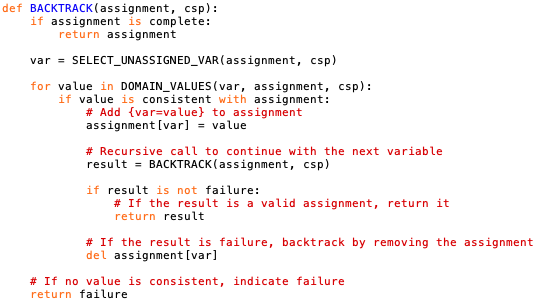|
||||||||
Backtracking Search - Python Automation and Machine Learning for ICs - - An Online Book - |
||||||||
| Python Automation and Machine Learning for ICs http://www.globalsino.com/ICs/ | ||||||||
| Chapter/Index: Introduction | A | B | C | D | E | F | G | H | I | J | K | L | M | N | O | P | Q | R | S | T | U | V | W | X | Y | Z | Appendix | ||||||||
================================================================================= In machine learning, backtracking search is a search algorithm commonly used in optimization problems. It is particularly applied in scenarios where there is a need to explore different possible solutions systematically to find the optimal solution. Backtracking search is often used in combination with constraint satisfaction problems. The basic idea of how backtracking search works is:
Backtracking is particularly useful when the search space is large, and it allows the algorithm to efficiently explore different paths without examining all possibilities. It prunes the search space by discarding branches that cannot lead to a valid solution. This approach is commonly used in various optimization problems, such as the N-Queens problem, Sudoku, and other combinatorial problems. The effectiveness of backtracking search depends on the problem's characteristics and the efficiency of constraint checking. An example code of is (code): The code provides a general structure for backtracking search and needs to be adapted to the constraints and requirements of a particular problem. For instance, we need to replace the placeholders like is complete, SELECT_UNASSIGNED_VAR, DOMAIN_VALUES, and is consistent with assignment with the actual conditions and functions based on the specific problem we are solving with the backtracking search algorithm. This backtracking search function above can be applied to the classic N-Queens problem. In the N-Queens problem, we need to place N queens on an N×N chessboard in such a way that no two queens threaten each other (code). In this example, the is_complete, select_unassigned_var, domain_values, and is_consistent functions are defined based on the specific requirements of the N-Queens problem. The n_queens_backtrack function initializes the problem and calls the BACKTRACK function to find a solution. The constraint is typically checked in the is_consistent function. In the provided code, the is_consistent function checks whether placing a queen at a specific position is consistent with the existing assignment. The constraints for the N-Queens problem are:
In this function: where,
If any of these conditions is true, the function returns False, indicating that placing a queen at the given position would violate the constraints. Otherwise, it returns True, indicating that the placement is consistent with the constraints. This function is called within the backtracking search algorithm to ensure that only valid placements are considered. The result will be a valid placement of queens on the chessboard. The output of the code is:
This output represents a solution to the 8-Queens problem. Each key-value pair in the dictionary corresponds to a queen placed on the chessboard. The keys represent the columns (horizontal positions) of the chessboard, and the values represent the rows (vertical positions) where the queens are placed.
Each queen is placed in a way that no two queens threaten each other, satisfying the constraints of the N-Queens problem. For example, no two queens share the same row, column, or diagonal. This configuration ensures a valid solution to the 8-Queens problem. ============================================
|
||||||||
| ================================================================================= | ||||||||
|
|
||||||||


